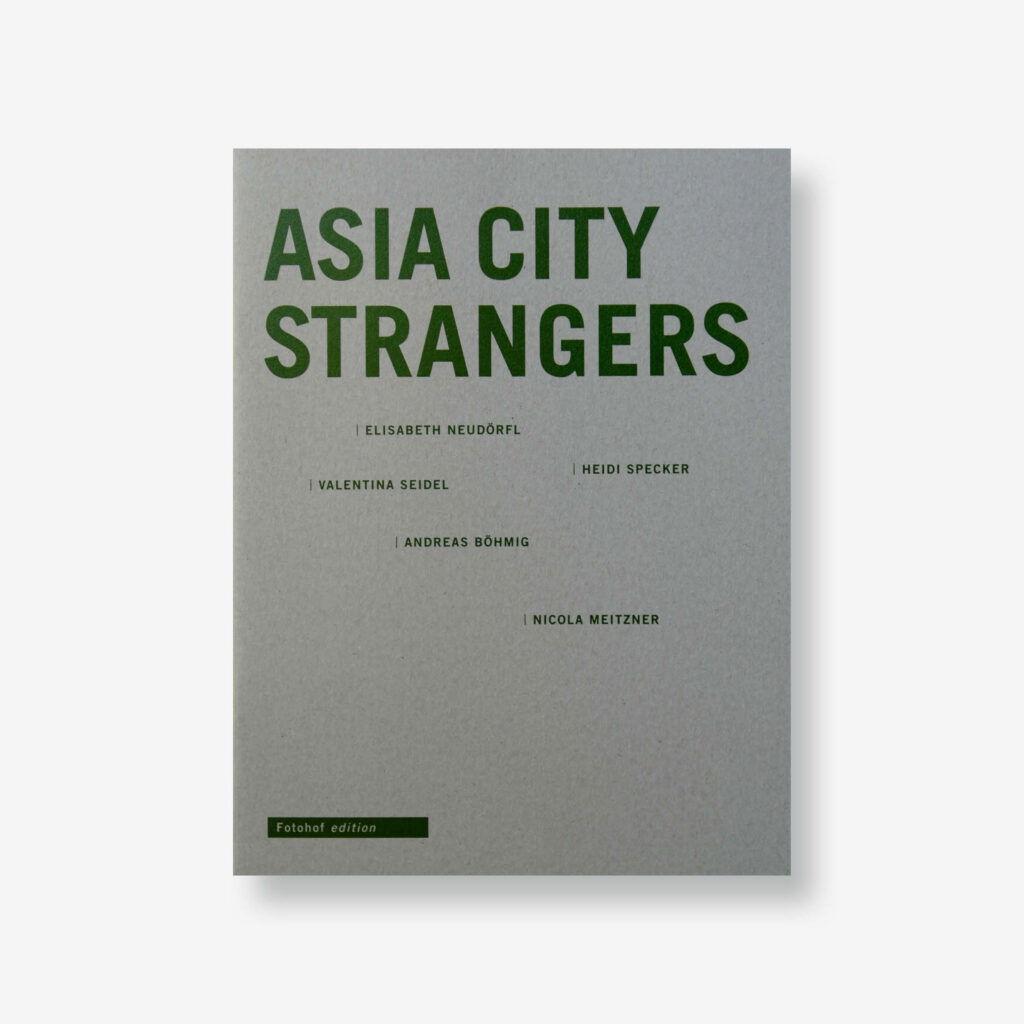Asia City Strangers
Heidi Specker, Andreas Böhmig, Valentina Seidel, Nicola Meitzner, Elisabeth Neudörfl
The exhibition thematises the space of Asian metropolises through five current photographic positions. The widespread idea of Asia as a contradictory cultural space, on the one hand committed to tradition, on the other a leader of technological progress, is exposed to an individual artistic experience. For the European perspective, these places oscillate “between the foreignness of an exotic-looking culture and the familiarity of a highly developed industrial society” (Bettina Lockemann, “Das Fremde Sehen”). The five photographic works have in common that they do not deal with the fragmented, the fleeting impressions of a large city, but focus on the moment of slowing down, focusing and rearranging in the sense of documentary-oriented, photographic concepts. In the catalogue text, Miriam Paeslack deals more intensively with the theme of “third space”, which is the common place of action of the five positions. “Third space” is to be understood as a separate, here artistic, space of action that provides new, as yet undefined possibilities of confrontation and self-perception: “The third space that emerges in the works, in the exhibition space and finally in our heads is always to be determined anew. (Miriam Paeslack, “Asia City Strangers”)

Heidi Specker’s works defy any temporal attribution. With her motifs “found” in Bangkok, she speaks of “encounters”. She concentrates on the moment and once she has found her motif, she separates herself from everything that surrounds it. The reduction to the two-dimensionality of the surface completely divests the picture of narrative moments. The results are collage-like picture walls consisting of small-format, slightly rosé-coloured pictures. In her works, Specker questions the relationship between construction and deconstruction in both the process of image-making and that of reception. Nicola Meitzner divides the cityscape into people and space. The compressed, artificial-looking city spaces of Tokyo are complemented by “close-up” portraits of the people moving about there, in the same image format. In their combination, these two types of images, people and city, form “the “yin” and “yang” of the urban in itself” (Miriam Paeslack, “Asia City Strangers”). By making the proportion of city views in Meitzner’s multi-part image grid higher than that of portraits, “a sense of balance of human and city is created overall, as the conscious visual capture of portraits is higher than that of city images” (Miriam Paeslack, “Asia City Strangers”). In her work “forward motion”, Meitzner addresses the area between “liveliness and chaos, between control and social rule, pointing far beyond the borders of Singapore” (Miriam Paeslack, “Asia City Strangers”).
Valentina Seidel shows exclusively portraits of Asian artists in this exhibition. She intensively involves the portrayed artists in the creation of the portraits. In the collaborative work “exchange”, she leaves the choice of the location, the posture and even the choice of the image detail primarily to the portrayed, thus taking the direction of her images out of their hands. These “extended portraits” lead to a conscious connection between the person portrayed and the urban situation. They possibly strive to provide information, a kind of insight into “being human in the city”. Elisabeth Neudörfl’s photographs were taken in a district of Bangkok that is the main attraction for Western sex tourism. In her pictures, she deliberately refrains completely from depicting people. The sprawling contraptions of the neon signs in the amusement district, depicted in sober daylight and looking upwards, expose through the way they are presented: “In not showing her black and white photographs, these documents of “meticulous curiosity”, she (Neudörfl) exposes the subtext of the place/space.” (Miriam Paeslack, “Asia City Strangers”) In his photographs, Andreas Böhmig documents the publicly celebrated self-expression of the radical fundamentalist Hindu movement of the “RSS” in Mumbai/India. Through morning appeal-like rituals, public space is temporarily occupied and the cityscape is shaped on a daily basis. The “RSS” fights for Hindu nationalism and tries to publicly establish its claim to power through these rituals. The images express order as well as absolute control, “the individual dissolves into the mass, disappears in the face of a “higher” principle” (Miriam Paeslack, “Asia City Strangers”). Böhmig’s colourful and precise photographs are impressive evidence of the political instrumentalisation of urban space.
